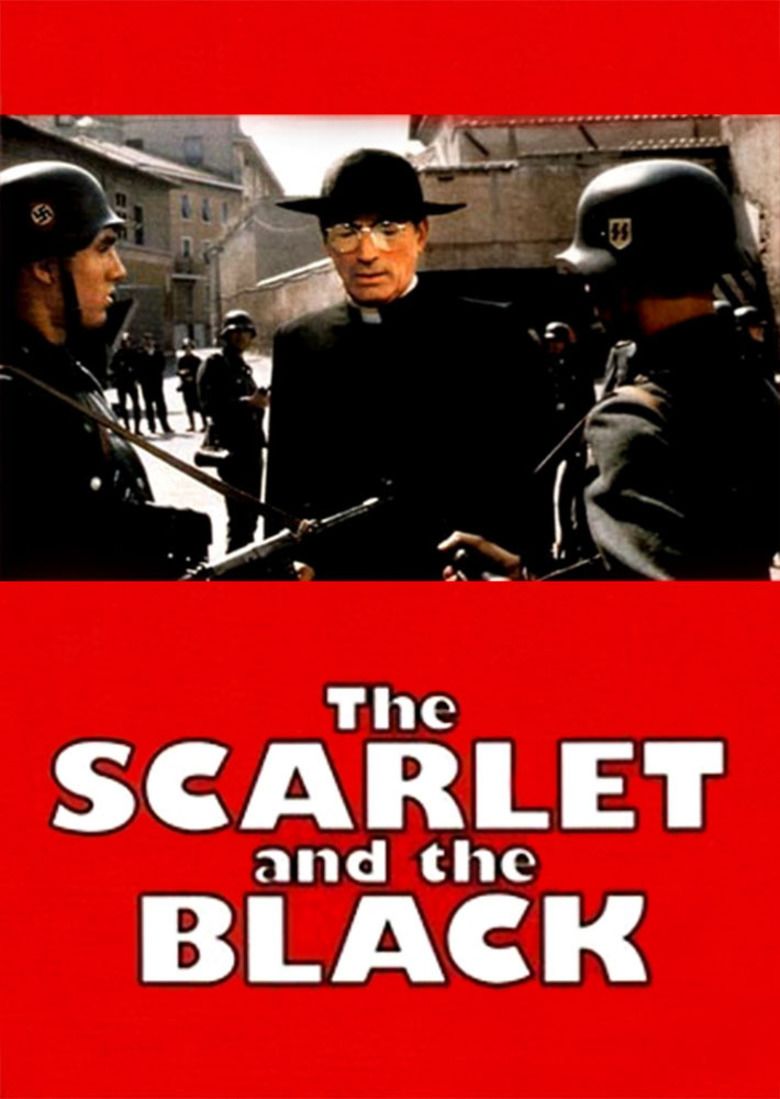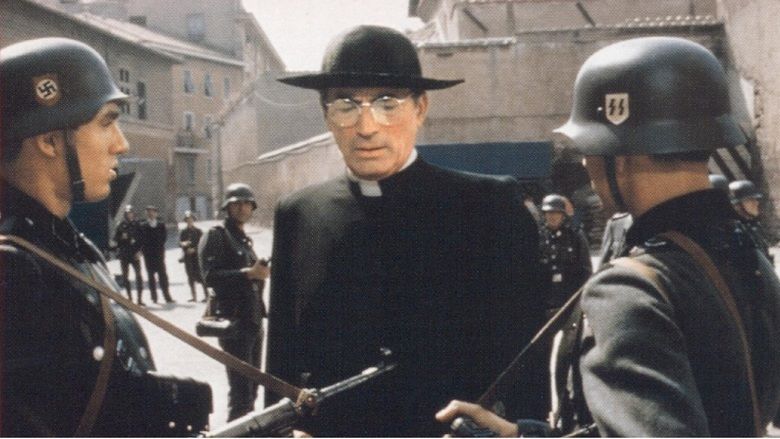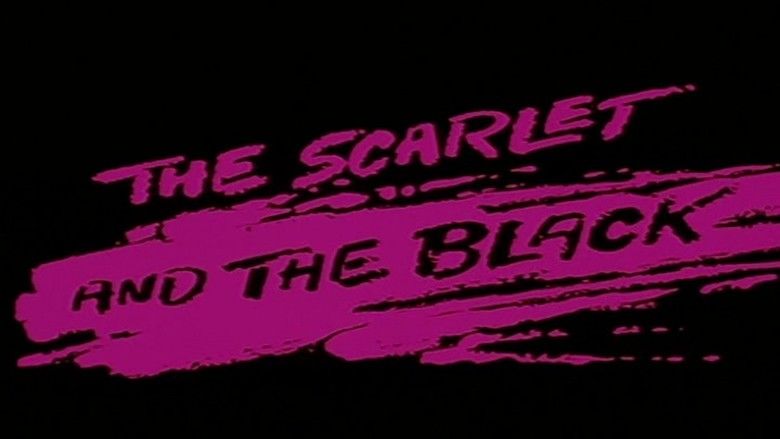The Scarlet and the Black
7.8 /10 1 Votes
Initial DVD release April 22, 2003 Language English | 7.8/10 IMDb Genre Drama, History, War Duration | |||||||||||||||||||||||||||||||||
 | ||||||||||||||||||||||||||||||||||
Release date February 2, 1983 Based on The Scarlet Pimpernel of the Vatican Nominations Primetime Emmy Award for Outstanding Achievement in Graphic Design and Title Sequences Cast (Monsignor Hugh O'Flaherty), (Col. Herbert Kappler), (Capt. Hirsch), (Minna Kappler), (Francesca Lombardo), (Pope Pius XII) Similar movies Ennio Morricone composed the music for The Scarlet and the Black and Massacre in Rome | ||||||||||||||||||||||||||||||||||
The Scarlet and the Black is a 1983 television film starring Gregory Peck and Christopher Plummer. The production should not be confused with the 1993 British television miniseries Scarlet and Black, which starred Ewan McGregor and Rachel Weisz.
Contents

Based on J. P. Gallagher's book The Scarlet Pimpernel of the Vatican (published in 1967), the film tells the story of Monsignor Hugh O'Flaherty, a real life Irish-born Roman Catholic priest who saved thousands of Jews and escaped Allied POWs in Rome. It was directed by Jerry London.

The title The Scarlet and the Black is a reference not only to the black cassock and scarlet sash worn by Monsignores and bishops in the Roman Catholic Church, but also to the dominant colors of Nazi Party regalia.
Plot
In 1943, the Nazi military occupies Rome. Pope Pius XII (John Gielgud) is approached by General Max Helm and SS Head of Police for Rome Lieutenant Colonel Herbert Kappler (Christopher Plummer). The Colonel expresses concern that escaped Allied prisoners may attempt to seek refuge in the Vatican, and requests permission to paint a white line across St. Peter's Square in order to mark the extent of Vatican sovereignty. The Pope grants his permission, but when the SS officers leave, he sees out of the window that the white line had already begun to be painted.
Kappler's main antagonist is Monsignor O'Flaherty (Gregory Peck), an Irish-born Vatican priest who runs an underground organization which provides safe haven and escape to escaped POWs, Jews, and refugees in Rome. O'Flaherty is assisted in this enterprise by others, including locals, clergy and the diplomatic corps. The Nazis attempt to destroy the group, but Kappler is frustrated by O'Flaherty's successes, due to his cleverness, disguises, and stressing the limits of the Vatican's neutrality.
Met with continuous failure, Kappler begins to develop a personal vendetta against O'Flaherty. Despite O'Flaherty's efforts, Kappler manages to recapture many escaped POWs, deport many Jews to death camps, and exploit and oppress the general population; a number of O'Flaherty's friends are also arrested or killed. O'Flaherty is himself the target of an assassination attempt instigated by Kappler, which however fails due to the monsignor's boxing skills. The rescue organization continues operating, and succeeds in saving many lives.
As the war progresses, the Allies succeed in landing in Italy and begin to overcome German resistance, eventually breaking through and heading towards Rome itself. Colonel Kappler worries for his family's safety from vengeful partisans, and, in a one-to-one meeting with O'Flaherty, asks him to save his family, appealing to the same values that motivated O'Flaherty to save so many others. The Monsignor, however, refuses, refusing to believe that, after all the Colonel has done and all the atrocities he is responsible for, he would expect mercy and forgiveness automatically, simply because he asks for it, and departs in disgust.
As the Allies enter Rome in June, 1944, Monsignor O'Flaherty joins in the celebration of the liberation, and somberly toasts those who did not live to see it. Kappler is captured in 1945 and interrogated by the Allies. In the course of his interrogation, he is informed that his wife and children were smuggled out of Italy and escaped unharmed into Switzerland. Upon being asked who helped them, Kappler realizes who it must have been, but responds simply that he does not know.
The film epilogue states that O'Flaherty was decorated by several Allied governments after the war. Kappler was sentenced to life imprisonment, but was frequently visited in prison by O'Flaherty, his only regular visitor. Eventually, the former SS officer converted to the Roman Catholic faith, and was baptized by the Monsignor in 1959.
Cast
Vatican Officials
SS Personnel
Allied Personnel
Civilians
Historical accuracy
The character of General Max Helm was based entirely on the real life of SS-Obergruppenführer Karl Wolff, who served in 1944 as the Supreme SS and Police Leader of Italy. The film was unable to use Wolff's real name, since the SS General was still living when the film was in production; he died in 1984.
Actor Christopher Plummer was 53 years old during the production of the film. Herbert Kappler was only 36 when he served as SS Security Chief in Rome.
Monsignor Hugh O'Flaherty was a real Irish-born priest and Vatican official, credited with saving 6,500 Jews and Allied war prisoners.
Herbert Kappler was sentenced to life imprisonment, and did convert to Roman Catholicism in 1959, partly under the influence of his war-time opponent Hugh O'Flaherty, who visited Kappler in prison every month, discussing religion and literature with him. He was eventually transferred to a prison hospital on account of poor health. It was there that he escaped imprisonment by being smuggled out in a suitcase by his wife (Kappler weighed less than 105 pounds at the time). He escaped to West Germany, where he eventually died at age 70 in 1978.
Awards
In 1983 The Scarlet and the Black was nominated for an Emmy in the category Outstanding Film Editing for a Limited Series or a Special.
References
The Scarlet and the Black WikipediaThe Scarlet and the Black IMDb The Scarlet and the Black themoviedb.org
